Notojima Glass Art Museum
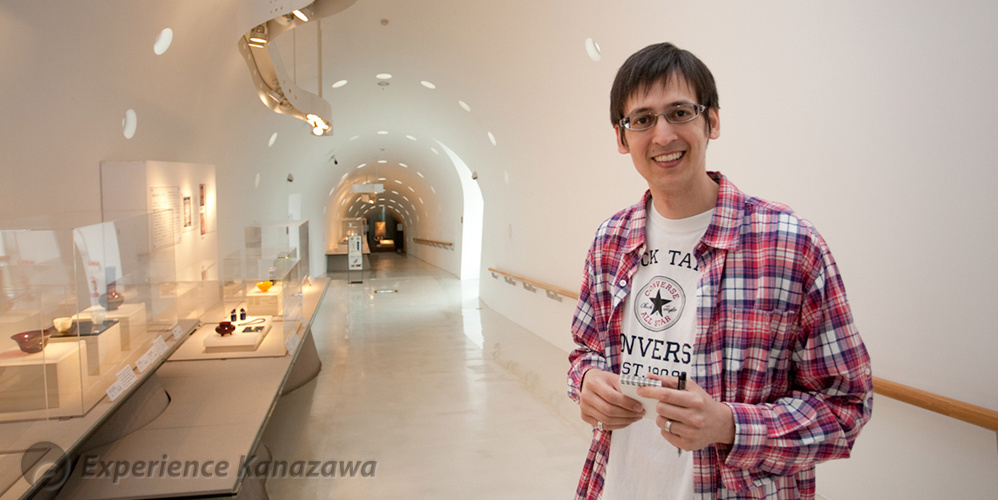
A Starship in the Rough. A Visti to the Notojima Glass Art Museum.
Across the Nanao Bay from the 1200 year old hot spring in Wakura Onsen is Notojima Island at the heart of the Noto Peninsula. The approach to the Notoijma Bridge which carries you to the island is along an unspectacular slightly winding road with a tree-covered hill on the left and a slight rise with a few buildings on the right that keeps the surrounding area hidden from view. The effect is such that when the road straightens out and you hit the first steep incline of the bridge it feels a bit like flying--taking off over the shimmering deep blue waters of the bay into the pale blue sky, with the view of the green hills of the coast and island in the distance opening up around you.
I love the Japanese countryside. It changes colors with the seasons, and each season is beautiful. In any season you can expect to see great expanses of rice fields, hills large and small forested with bamboo, cedar, and cypress, country homes with traditional black tile roofs, and lovely seasonal flowers like cherry blossoms, hydrangeas, and cosmos. And then, in much of Japan and especially here in the Noto Peninsula, the sea is never far. With its countless jagged tree-covered islets scattered about just off the coast, the sea provides views even more spectacular, and the small fishing villages here and there give a deeper sense of rural Japan.
By the time you reach Notojima Island you will have already had plenty of time to take in the scenic countryside along the way, and the views of the bay and the peninsula from the large bridge. And although the beauty of it is undeniable, it’s only natural for you to expect to see more of the same as you go. Compared with the mainland, Notojima Island has even fewer buildings and most of them are traditional homes, so nothing in the surrounding environment prepares you for what you come upon next: your eyes are drawn by the glint of metal and glass on the large hill to the left. It takes a moment to understand exactly what it is you’re seeing. Like some half buried starship rising from the ground, or an extra-planetary research facility from a science fiction movie, it leaves you with two questions: What is this place! And what in the world is it doing in the middle of the Japanese countryside?
By Mark-Edmond Howell; Published: June 20, 2011
Notojima Glass Art Museum / 125-10, Kohdamachi, Notojima, Nanao City
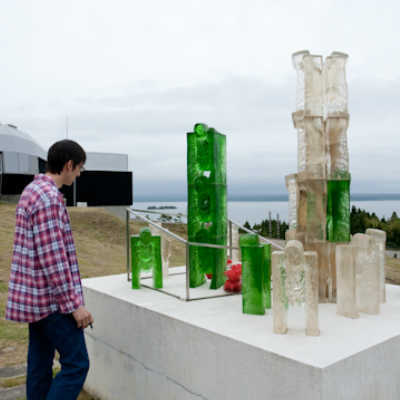
The futuristic buildings themselves are something of an enormous work of art worth experiencing in their own right.
Welcome to the Notojima Glass Art Museum. Constructed in 1991 the museum was the brain child of glass artist, and author, Tsuneyo Yoshimizu who among many other notable things founded the glass workshop in an old schoolhouse across the road from where the museum stands today. Ultimately realized by the prefectural government (with the aid of some large private contributions), the idea was to create something on Notojima Island to draw visitors once the Notojima Bridge was completed the same year.
Although the glass art museum draws nearly 50,000 visitors a year, the most popular tourist attraction on Notojima Island is in fact its aquarium. Easily the largest aquarium in this region, it is also rather impressive: aside from the myriads of fish, there are sea otters, sea lions, penguins, the crowd-pleasing dolphin show and--since its renovations were completed in 2010--an enormous whale shark in a brand new tank and building. It’s a great place to bring the kids for an afternoon. And yet, it’s the more unique Notojima Glass Art Museum that I always bring friends and family when they visit from overseas.
Today I visited the glass art museum again, and was reminded of just how great a place it really is. The permanent collection of glass art and the temporary exhibits are absolutely worth seeing and I’ll explain more about that in a moment, but for anyone at all interested in art or architectural design, the futuristic buildings themselves are something of an enormous work of art worth experiencing in their own right.
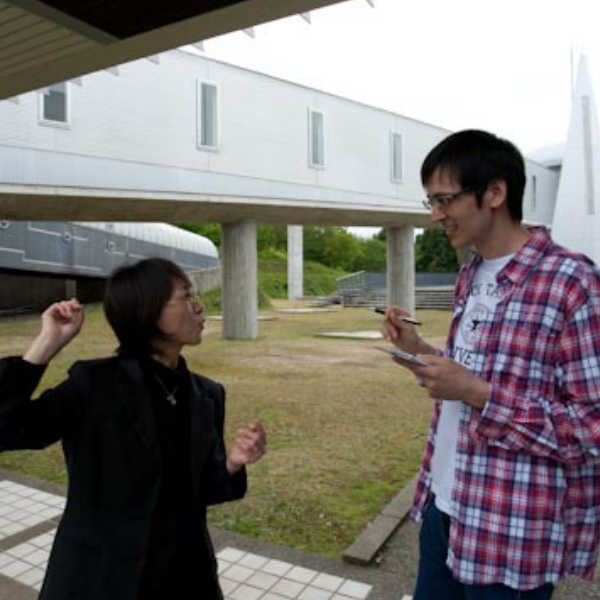
My experience of the museum today began with this first look from below and proceeded from there as I approached the entrance.
There is a parking lot at the top of the hill where the museum sits, though I recommend parking across the road at the bottom near the glass art workshop. This gives you a better view of the museum from below and enhances the surprising initial effect of coming upon the intriguing museum buildings amidst the country island surroundings.
glass_museum-5531.jpgMy experience of the museum today began with this first look from below and proceeded from there as I approached the entrance. Part of the beauty of the museum is the exquisite way it combines straight lines, simple circular arcs, and more organic irregularly curving lines. True to this style, there are two paths up to the entrance—one a straight stairway, the other a meandering walking path that takes you past a number of large glass works of art that grace the hill with an eclectic and alien atmosphere. I took the walking path.
glass_museum-5547.jpgEach work made for the museum by a separate artist, they are all very different and each one has its own unique appeal. “COSMIC FLY” is comprised of two vertical panes of glass with four rough cut square shafts of stone going through them, one near each corner. “Mother and Child,” titled “Play in the Sea” in Japanese, is two white and purple glass arches with two figures, one large one small, sitting at the peak of one of the arches. “Talk” is made up of two colorful intersecting crosses that reflect the viewer in two different sizes in eight different places. Altogether there are 14 different glass art works that can be viewed outside.
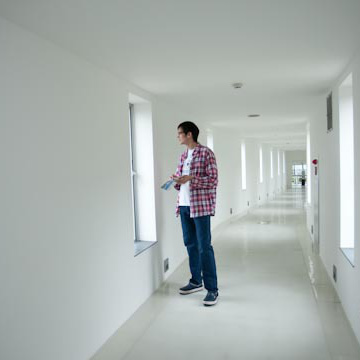
English pamphlet, notepad and pen in hand, I stepped through the heavy bronze riveted doors
Eventually I made my way to the outer entrance which leads into the entry hall where visitors can buy their tickets. And finally I was ready to begin the second part of my experience: the interior and the exhibits. The cheerful Ms. Matsumoto of the museum staff accompanied me especially today and she was very helpful and informative about the museum in general and also about the current special exhibit: Qing Dynasty Glass, “Po-Li” the Glass Loved by Emperors.
English pamphlet, notepad and pen in hand, I stepped through the heavy bronze riveted doors—like something from a Jules Verne story—and into the first room of the museum beyond. Exhibition Room A is less of a room and more of a long white corridor that descends at a slight angle and by the trick of its design it seems to go on indefinitely. The arc of the ceiling, the lines of small circular porthole windows at regular intervals, the curving lines of the cloud-like light fixtures, work together to promote the futuristic space feel the outside began. The first display cases are on the left.
Often displaying glass works designed by Jean Cocteau, Jean Arp and others, today in Exhibition Room A there were 18th and 19th century Qing Dynasty glass art pieces on display that were truly a marvel to view up close. Many of the pieces featured a base color glass with a second color glass layer above that had been carved and cut away to create an intricate lace-like design in relief. The level of craftsmanship involved was simply amazing.

I let the staff talk me into trying on the Chinese emperor costume and replica glass bead necklace
As it turns out, the long white corridor of Exhibition Room A does have an end, a dead-end in fact, where today a particularly intriguing yellow glass bead necklace, once worn by a Qing emperor, was on display.
From here I backtracked to a hall jutting off to the left a short way up the corridor. This next hallway has a more angular feel and features large windows above and to the sides with the ceiling and walls at odd angles that make you feel like you’re tipping over. Not to worry, there’s a wooden lacquered handrail to help you keep your balance. Today, I learned for the first time that this handrail was designed specifically to incorporate lacquer-ware into the museum as it is one of the traditional crafts Ishikawa prefecture is famous for. A nice touch, that.
Taking another quick left, I continued up another hall, one that shrinks a bit as it rises, and arrived at the top of a wide spiral staircase in the center of a separate building called the Glass Dome. The building, although not a dome made of glass, is more or less circular and there is a large wooden “scale cloud” latticework hanging from the ceiling. The atmosphere here is more comfortable and descending to the second floor, called the Lobby, I let the staff talk me into trying on the Chinese emperor costume and replica glass bead necklace—made in the same way as the original—that was part of the Qing glass exhibit, and enjoyed having my picture taken.
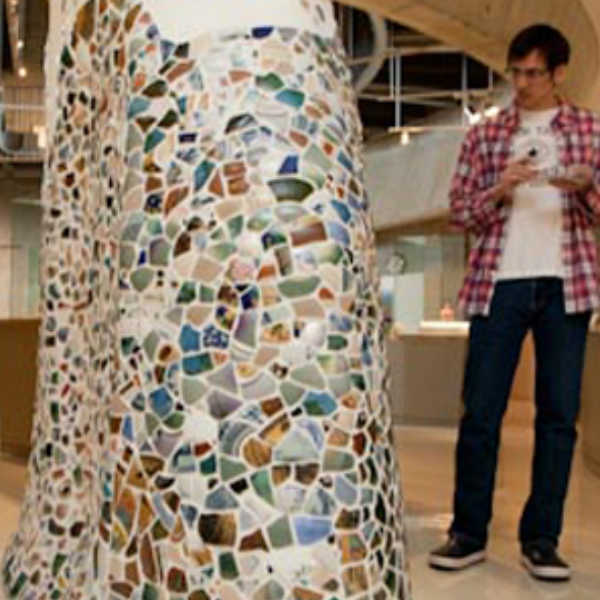
I stopped at the landing midway where there is a large cloudy circular window crosshatched with two vertical and two horizontal red wooden beams.
Taking the stairs down again to the first floor, called Exhibition Room D, there was a great number of Qing Dynasty glass art pieces on display, as well as a few pieces by the French glass artist Émille Gallé that were inspired by this Qing Dynasty glass art.
This display area is fairly large and one could spend quite a long time slowly perusing each piece there. The Elevator took me back to the shrinking hall (expanding going back) which in turn led me back to the off-balance hallway which followed to the end left me at the top of a short set of stairs that leads down into another building and Exhibition Rooms B and C. Before continuing all the way down to the rooms a few steps below, I stopped at the landing midway where there is a large cloudy circular window crosshatched with two vertical and two horizontal red wooden beams. Nothing spectacular at first, my guide urged me to take another step forward and snap! the window cleared instantly and showed a wonderful view of the sea far off below the hill. It had been long enough since my last visit that I’d forgotten about the effect and was pleasantly surprised anew. I was also surprised to learn that the window was made of liquid crystal glass panels and that it was part of the original design of the museum way back in 1991. Just to show off my ignorance, I didn’t even know liquid crystal panel technology was around back then!
Exhibition Rooms B and C, separated by the stairway between them, are long curving spaces with high ceilings—if the timing is right you can witness prism-induced rainbows stretching across them. In one room was more beautiful Chinese glass art, among them tiny bottles painted in incredible miniature detail, some from the inside! There was a video showing one artist at work painting the inside of a bottle with specialty brushes and it was incredible.
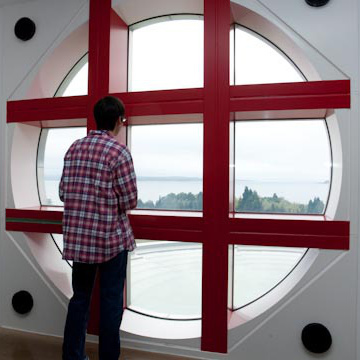
Collaboration with world-renowned artists such as Picasso and Chagal
In the final room I visited there were the museum’s pride pieces—part of the permanent collection. These are works of glass art done by the Italian artist Egidio Constantini in collaboration with world-renowned artists such as Picasso and Chagal—each piece maintaining the distinct style of the more famous artist masters Constantini collaborated with. Also, there are works designed by Salvador Dali and produced by the French crystal studio Daum; anyone familiar with the work of these big-name artists will not want to miss the chance to see their art done in glass. And finally, there are fascinating works done by more contemporary Japanese and international glass artists, as well.
In the end, I stepped out the exit between Exhibit Rooms B and C, satisfied by the interior and exhibits. The round ball shaped building off to the left isn’t an escape pod, it’s the gift shop and café where you can pick up souvenirs or just relax over a cup of coffee in its unique environment. After a brief stop there, I headed back past the tall, narrow, pyramid shaped Eight Towers—each topped with a crystal prism—and made my way over to the Veranda outside the Glass Dome. There I spent some time just taking in the Japanese dry landscape garden below and the inspiring view of the sea beyond with the wind on my face, and thinking about how fortunate I am to live where I do.
Japan has far more than the standard tourist fare of temples and shrines to offer international guests, and if you’re ever in the Noto Peninsula I highly recommend the Notojima Glass Art Museum.
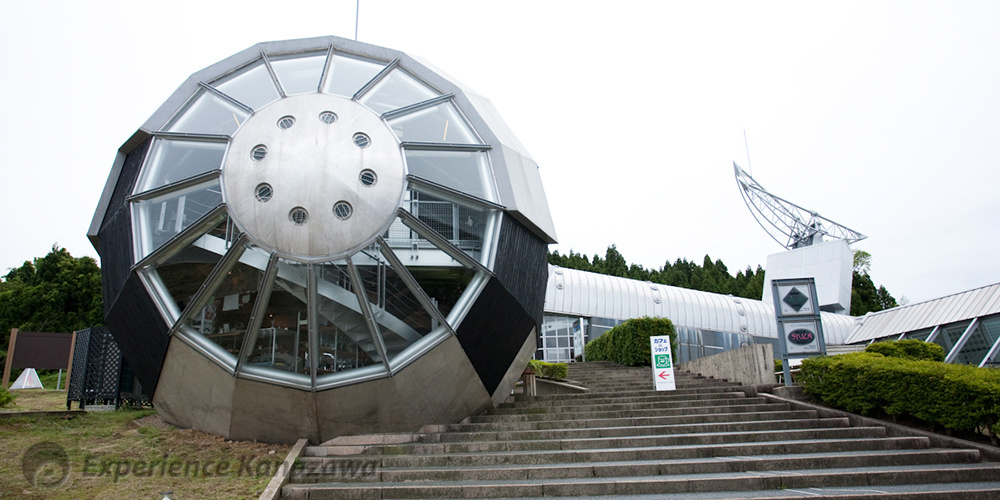
Kanazawa Area
Kenrokuenn Garden
Following Matsuo Bashô’s steps in Ishikawa - 1/6 [Introduction]
Following Matsuo Bashô’s steps in Ishikawa - 2/6 [Kanazawa]
Noto Area
Mitsukejima Island
Kaga Area
Following Matsuo Bashô’s steps in Ishikawa - 3/6 [Komatsu City]
Following Matsuo Bashô’s steps in Ishikawa - 4/6 [Natadera Temple]
Following Matsuo Bashô’s steps in Ishikawa - 5/6 [Yamanaka Onsen Town]
Following Matsuo Bashô’s steps in Ishikawa - 6/6 [Daishoji District]
Rosanjin in Yamashiro Onsen Town
Stroll Kanazawa in Rental Kimono - 1/2 [Kimono Rental]
Stroll Kanazawa in Rental Kimono - 2/2 [Kimono Stroll]
January
Enyukai: Geisha Party
February
Setsubun-Sai Festival
AUGUST
Issaki Hoh-Toh Matsuri
November
Enyukai: Geisha Party

